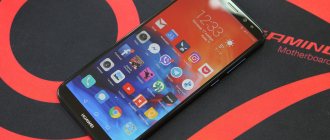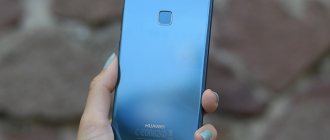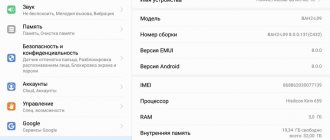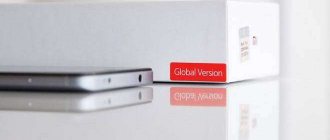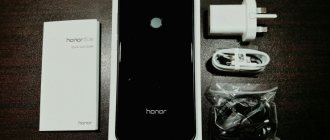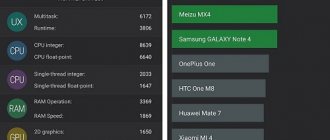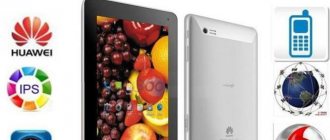Review of the Huawei P9 Lite smartphone and its characteristics
Huawei P9 is one of the main flagships of the manufacturer, which not everyone can afford yet.
It was created to compete with famous European and Korean flagships, and its junior modification Huawei P9 Lite received a compact body and an attractive price, which makes its purchase the optimal solution for many. The smartphone does not have a dual main camera module, its hardware is also rather close to average, but it has an excellent screen, full functionality of the EMUI shell and a fingerprint scanner. Let's review the Huawei P9 Lite and you will be able to understand what will be better for you - to get it for a flagship or to immediately get a simplified version.
Buy a smartphone
Equipment
Since the Russian office still does not provide complete gadgets for testing (they only sent a smartphone and, for some reason, a USB Type-C cable), I had to scour the Internet for unboxing photos of the Huawei P9 Lite.
As you can see, the equipment is more or less standard: a Micro USB power cable, a charging block, a wired headset and a box with a fairly original appearance.
Design
The Huawei P9 Lite smartphone review moves on to consider the design, which turned out to be interesting. Huawei equipment always looks decent and the hero of our review was no exception. But unlike the older version, plastic is used as the main material.
There is a subtle striped pattern on the back and front panels, which makes the design more original. But if you remove the corporate logo on the front panel and put the screen in a locked state, you can easily confuse it with Xiaomi Redmi.
But the design of the back is more reminiscent of the older P9 model - it has a fingerprint scanner installed in the center, and on top we see a transparent insert with a built-in camera and flash.
When you pick up the phone, the expected effect of contact with cold metal does not occur, which, combined with the low weight, hints that in order to save money, the case has a plastic base. Only the frame is constructed of metal, which does not separate the plastic elements very carefully.
Huawei P9 Lite mini 2 black review showed that this does not affect the perception of the design, the device looks really beautiful. The plastic is of high quality - it does not become covered with fingerprints, which allows us to call it practical and did not receive a single scratch during the entire testing period.
The power control key and volume rocker are located on the right. They appear to be metal, but are actually made of plastic, like the rest of the body. A place for them was allocated on the right side.
The microSD card tray is combined with the second SIM card slot and is located on the left side.
At the top we see a traditional 3.5 jack for a headset, and it’s very good that they didn’t abandon it. An additional microphone is also installed here.
Huawei P9 Lite lte 16gb review informs you that the central place of the bottom panel is occupied by a micro-USB port. The main speaker and microphone were placed next to it.
The build quality is at the highest level, which is what you would expect from a manufacturer of this level - the parts sit tightly in the body, do not creak or play, only the above-mentioned side frame hints that the device belongs to the middle price category.
The smartphone is very convenient to use, its ergonomics are thought out to the smallest detail - the keys have a pleasant stroke and are located where you would expect to see them. The same goes for connectors. We didn’t forget about the event indicator. Huawei P9 Lite dual sim review showed that due to its compact size and light weight it is convenient to use with one hand.
The keys here are on-screen; if desired, their functionality and location can be set in the settings at your discretion. The scanner can be used not only to restrict access to the phone, but also to go to the notification shade, camera, and flip through photos.
Display
Huawei P9 Lite 2021 vns l21 review moves to a 5.2-inch display built using IPS technology. It received FullHD resolution and is covered with a flat protective glass with a good quality oleophobic coating. And to ensure maximum protection, the plastic side protrudes slightly above the rest of the case, which will save the screen if it falls.
The P9 Lit's display is surrounded by thin frames, which are completely invisible against a dark background. Thanks to this, the device should look great in any color options.
The factory calibration of the screen is far from the reference one - the color temperature is clearly too high, so after the first turn on you want to go to the settings and set your parameters there, which, fortunately, can be done.
Huawei P9 Lite lte dual sim review showed that the screen brightness level can be set in the range from 5 to 411 cd/m², and the contrast is 1 to 781. The picture is easy to read on the street, the screen is no worse or better than that of price competitors . Among the additional features, I would like to note the ability to operate with gloves, which is very useful during cold weather.
Advantages and disadvantages of the P9 Lite 2017 phone
The dimensions of Huawei P9 Lite 2021 are 72.94 mm wide, 147.2 mm long and 7.6 mm thick. With such dimensions it is convenient to operate the device with one hand. In addition, the weight of the device is about 147 g. Even if you operate the device with one hand, its weight is almost not felt.
If we evaluate the overall ease of use of the phone taking into account the size and weight, then there will be no problems with everyday use.
The smartphone is equipped with an 8-core Huawei HiSilicon KIRIN 655 processor, which is made on 16 nm. technical process.
The smartphone has 3 GB. RAM, which is quite enough. In very rare cases it will not be enough, but with this amount of RAM, you will rarely have problems.
The device's data storage capacity is 16 GB, and while this is enough for photos, it may not be enough for video shooting and a large number of games.
The phone is compatible with SD cards, so you can easily expand its memory. So you probably don't need to worry about storage capacity.
The P9 Lite 2021 has a display diagonal of 5.2 inches. The display is large enough that you will rarely have problems with its size. However, this display is not suitable for writing long texts.
The smartphone has a high-end display and any graphic content you display on it, including videos and games, will be displayed clearly.
The main camera of the phone has 11.81 megapixels, which should be enough in most cases. However, you may be slightly unsatisfied with the quality of the photos.
Also, the smartphone has a 7.99 megapixel front camera, which is average for smartphone cameras. This is good enough for taking selfies, but you may not be satisfied with group photos or their print quality.
The battery capacity of Huawei P9 Lite 2021 is 3000 mAh, which is a relatively large indicator. Compared to other smartphones, the battery life of Huawei P9 Lite 2021 is good. With this capacity, you won't experience any problems even if you spend time on the Internet or Twitter for a long period of time. Even while playing games or watching videos, you can do so comfortably without worrying about battery life. However, some caution should be exercised when watching movies or playing games for too long.
Performance of Huawei P9 Lite
Huawei P9 Lite specifications are based on a self-produced Kirin 650 processor, built using a 16-NM process technology. It consists of a pair of clusters, each of which has 4 Cortex-A53 cores with a frequency limit of 2 and 1.7 GHz. The Mali T830 MP2 video accelerator is responsible for the graphics.
Compared to the Kirin 620, we have a 60% increase in CPU and 100% in GPU, which is very impressive. The new i5 coprocessor, which collects and processes data from all sensors of the device, deserves special mention. It received an increase in performance, but at the same time began to consume less energy.
Synthetics:
The technical characteristics of the Huawei P9 Lite suggest the presence of only 2 GB of RAM combined with 16 GB of user memory, of which 10.5 GB remains for use. In 2021, this volume will not be enough for most users, and therefore it is worth considering purchasing a microSD card. But in order to increase the amount of space, you will have to sacrifice a second SIM card. The micro-USB port does not support the ability to connect external devices via OTG.
Huawei P9 Lite gold 2 16gb review showed that according to the results of synthetic tests, Kirin 650 is comparable to another mid-range chip Helio P10 from MediaTek. Kirin is slightly superior in terms of graphics, but otherwise we see an identical result.
The smartphone is average in terms of performance - it can handle most games, but at maximum graphics the fps will be average and the experience will not be the same. You can still play Tanks on high graphics, but in more demanding games we see no more than 30 fps. There are no brakes or delays, which is nice.
⇡#Hardware and performance
The smartphone runs on the new Kirin 650 system-on-chip produced by Huawei subsidiary HiSilicon. Essentially, this is an improved analogue of the HiSilicon Kirin 930 chip, which was installed in last year’s flagship model Huawei P8. The 650, like the 930, has eight ARM Cortex-A53 cores: four of them operate at a frequency of 1.7 GHz (in the Kirin 930 - at a frequency of 1.5 GHz) and four more at a frequency of 2 GHz. The chip is made using a 28-nanometer process.
RAM in Huawei P9 Lite can be two or three gigabytes, depending on the version chosen. The smartphone that arrived at our test laboratory turned out to have 2 GB. The volume of built-in flash memory is 16 GB. If necessary, expansion is available using a microSD memory card, but for this you will have to sacrifice the connector for the second SIM card - the slot here is universal.
The level of performance of the Kirin 650 in conjunction with two gigabytes of RAM is quite standard for a mid-priced platform. In the general synthetic test AnTuTu Benchmark 5, the Huawei P9 Lite smartphone scored 47 thousand points. The result is quite acceptable for a device costing 20 thousand rubles - classmates in this test receive similar scores.
The ARM Mali-T830MP2 module operating at 600 MHz is used as a graphics controller. The coprocessor does an excellent job of displaying video in the screen’s native high-definition resolution and quickly rendering images for not very resource-intensive applications. In the light gaming test Basemark 2 Taiji, the gadget showed 58.5 frames per second, that is, it almost hit the vSync limit of 60 FPS.
It is difficult to cope with the “heavier” Huawei P9 Lite toys - the picture begins to slow down, the number of frames per second treacherously drops below the treasured 30 FPS. In gaming benchmarks, he scored lower than his classmates. It is obvious that the Kirin 650 platform is not designed for gamers at all.
During everyday use, the gadget operates smoothly and stably, without slowing down when displaying operating system animations and switching between applications. This is probably due not only to the computing system, but also to the well-debugged Emotion UI software shell. The smartphone copes very well with web surfing, viewing electronic documents, multimedia tasks and navigation. The situation here, by and large, is absolutely standard for a mid-priced gadget. We know of only one exception to this rule - ASUS Zenfone 2.
Autonomy
The Huawei P9 Lite review moves on to its 3000mAh battery. The manufacturer promised to improve power consumption when developing a new chip, and after testing we can confidently say that it succeeded. Compared to the P8 lite, it has become much more durable under the same testing modes. But it’s a stretch to call it a long-liver, because with active use it barely survives until the evening.
When reading at the minimum comfortable brightness level, the autonomy lasted for 14.5 hours. Huawei P9 Lite 16 GB review showed that continuous video playback left the phone at half brightness in 10 hours. In games it lasted a little over 4 hours.
Interface
The Huawei P9 Lite 2 black review demonstrates that it uses the proprietary Emotion UI 4.1 shell, based on version 6 of Android. Its distinctive features include the ability to control gestures and a virtual key, when pressed, a radial menu is displayed. This is very convenient when operating with one hand; you can immediately see the main functions in front of you. You can choose from thousands of available themes and switch to a simplified desktop display mode. The purpose of the function keys can be changed at your discretion.
Huawei P9 Light review showed that current events are displayed on the top curtain. It is divided into several menus; when you scroll to the second menu, we see shortcut icons for many functions, and there will be even more of them if you swipe your finger from bottom to top.
Huawei P9 Lite results in AnTutu Benchmark
In the popular AnTuTu benchmark, the Huawei P9 Lite smartphone scores an average of about 52934 points. This figure, like all those given below, was taken from the official website of the developer of this software. Unfortunately, we currently do not have detailed data on the device's performance in AnTutu.
Comparison with other smartphones from the ratings of different years
| Model | Platform | Memory | CPU rating | UX assessment | 3D assessment | Overall rating | |
| 1 | Samsung Galaxy S7 Edge (SM-G935T) | Snapdragon 820 | 4 Gb + 32 Gb | 26043 | 43398 | 54343 | 132304 |
| 2 | ZTE Nubia Z11 | Snapdragon 820 | 6 Gb + 64 Gb | 30823 | 32093 | 58179 | 131770 |
| 3 | Samsung Galaxy S7 Edge (SM-G935V) | Snapdragon 820 | 4 Gb + 32 Gb | 25151 | 43288 | 53915 | 130961 |
| 4 | Huawei Mate 9 Pro | Kirin 960 | 6 Gb + 128 Gb | 32506 | 44230 | 42376 | 129677 |
| 5 | Sony Xperia X Performance | Snapdragon 820 | 3 Gb + 32 Gb | 27578 | 36602 | 54177 | 126543 |
| 6 | Huawei P9 | Kirin 955 | 3 Gb + 32 Gb | 34516 | 36516 | 17665 | 94117 |
| 7 | Huawei P9 Plus | Kirin 955 | 4 Gb + 32 Gb | 33461 | 36761 | 17429 | 93896 |
| 8 | Huawei Honor 8 | Kirin 950 | 4 Gb + 32 Gb | 32413 | 35319 | 18420 | 92348 |
| 9 | Apple iPhone 6 Plus | Apple A8 | 1 Gb + 128 Gb | 27006 | 24266 | 24882 | 83289 |
| 10 | Apple iPhone 6 | Apple A8 | 1 Gb + 32 Gb | 43319 | 23454 | 12348 | 79230 |
| 11 | Huawei P9 Lite | Kirin 650 | 3 Gb + 16 Gb | 52934 |
The rating of devices on the official AnTuTu website is updated once a month. Old data is available via Web Archive.
Top
Huawei P9 Lite camera review
If the development of the Huawei P9 camera was carried out jointly with Leica, then there is nothing like that. The phone received a 13-megapixel main camera and an 8-megapixel front camera. The latter doesn't shoot perfectly, but in good lighting you can get amazing selfies. Huawei P9 Lite camera review showed that the front camera was not equipped with an LED flash, but instead, when shooting in low light, the backlight of the screen itself is used. It turns on a moment before shooting.
The main camera uses a Sony IMX214 module with f/2.0 aperture, in addition to which there is a bright flash. Autofocus works flawlessly - everything is fast and clear.
The interface of the Camera application contains so many settings and shooting modes that you can easily get lost in them. But all menu elements are built logically, and the interface is easy to use. A gesture on the left can display available shooting modes, and on the right - camera parameters. Below is a menu for those who like to experiment with manual shooting settings. Huawei P9 Lite review in Russian showed that you can set white balance, ISO, shutter speed, control focus and much more.
Example photo:
Video shooting can be carried out in FullHD resolution with 30 fps, which the manufacturer rather did on purpose, leaving 4K only in its flagships. Slow motion shooting is possible in 720p resolution at 120 fps.
There is stabilization here, but when shooting on the go it plays virtually no role. In terms of quality, we have well-detailed videos, but the overall impression is spoiled by small stutters and speed dips. The suppression system suppresses extraneous noise well, providing high quality sound when recording.
The overall verdict is that the camera is serviceable and is approximately on par with its competitors. In some places traces of software processing are visible, due to which detail is lost in some frames. The main disappointment was the sharpness zones at the edges of the image, but you don’t remember about them when shooting at a short distance.
Conclusion
Huawei P9 Lite dual sim black review has come to an end and it's time to sum it up. It has already become commonplace for us that gadgets from China are much cheaper than their European competitors with identical characteristics. But the Huawei brand has managed to break into the global market, which is why the cost of its devices is gradually increasing and is already an order of magnitude higher than its Chinese competitors.
Huawei P9 Lite has become a pleasant exception to the rule, because for $182 they offer us a device with a fingerprint scanner, a FullHD display and good performance. What we regretted was the amount of RAM and built-in memory; there are really not enough of them here.
Where can I buy?
Following the links you can buy a smartphone at the best prices:
Aliexpress GearBest
Comments for the site
Cackl e
Huawei P8 Lite - a simplified version of the flagship
Huawei Y3 II - review of a budget phone from a leading Chinese manufacturer
Review of Huawei Honor 9 Lite - what did you have to sacrifice to significantly reduce the price of the flagship?
Review of Huawei Mate 20 Lite - what is interesting about the simplified flagship?
Huawei Mate 10 Lite review - a simplified version of the flagship that has a lot to offer
Honor 8 Lite is a great option for its price
Huawei Honor 3C is a modern smartphone with excellent characteristics
Huawei P20 Lite - review of the lightweight version of the flagship
Review of Huawei Honor 8X - a powerful phone with an edge-to-edge screen and NFC at a price below 20,000 rubles
Huawei P10 is one of the best offerings from the manufacturer, which, with the exception of a couple of minor flaws, turned out to be perfect
Review of the Huawei Honor 7S smartphone - a budget phone on Android Oreo with many disadvantages
Detailed technical specifications
Make and model
Make and model of the device, and alternative names (if any).
| Brand Device manufacturer company. | Huawei |
| Model Device name. | P9 Lite 2017 |
| Alternative names Other model names, if available. Sometimes the model is called differently, depending on the country or because of popular nicknames. | P9Lite 2021 PRA-L11 PRA-LX3 |
Design
Appearance of the device including dimensions, weight, volume, colors and materials.
| Width The horizontal side of the device when used in standard orientation. | 72.94 mm (millimeters) |
| Height The vertical side of the device when used in standard orientation. | 147.2 mm (millimeters) |
| Thickness The cross-sectional size of the device. | 7.6 mm (millimeters) |
| Weight How much does the device weigh excluding the case, SIM and memory cards and other additional elements. | 147 g (grams) |
| Volume Approximate value calculated using the formula: length times width times height. | 81.6 cm³ (cubic centimeters) |
| Colors What colors is the device available in? | Golden Black White Blue |
| Housing materials What materials is the body made of? | Aluminum alloy Glass |
System on a Chip (SoC)
A system on a chip, a single-chip system (System on a Chip, SoC) is when several systems performing different device functions are connected on one chip.
| System on a Chip (SoC) A single-chip system that contains components such as a processor, graphics accelerator, memory units, communication interfaces, etc., as well as software for the operation of the system. | Huawei HiSilicon KIRIN 655 |
Central processing unit (CPU)
| Central processing unit (CPU) The main component of the device is responsible for calculations and data processing. | 4x 2.1 GHz ARM Cortex-A53, 4x 1.7 GHz ARM Cortex-A53 |
| Technical process What technological process is used to make the chip? The smaller the process technology, the better - the chips consume less power and generate less heat. | 16 nm (nanometers) |
| Processor size Processor capacity is a parameter that indicates how many bits of data a processor register processes in 1 clock cycle. This is usually 32 or 64 bits. | 64 bit |
| Instruction Set Architecture Instruction set architecture (ISA) is a programmable part of the microprocessor core used by software to control the operation of the processor. | ARMv8-A |
| Number of processor cores The processor can be either single-core or multi-core. The performance of the processor depends on the number of cores (threads). The more cores working simultaneously, the higher the power consumption, so in mobile devices all cores are used only under high load. | 8 |
| CPU clock speed Clock speed is the number of operations per second that a processor or its core can achieve. The higher the frequency, the higher the overall performance of the device, but performance also depends on the processor architecture and the number of cores. | 2100 MHz (megahertz) |
Graphics Processing Unit (GPU)
| Graphics Processing Unit (GPU) The graphics processing unit (GPU) is used to process and display graphics - 3D effects, games, interfaces and other visual elements. Due to the pipeline architecture, the GPU is many times more efficient in graphics processing than the processor. | ARM Mali-T830 MP2 |
| Number of GPU cores Similar to a processor, a GPU can have one core or several. The number of cores (threads) determines the performance and amount of information processed. The more cores, the better. | 2 |
| GPU clock speed Clock speed is the number of operations per second that the GPU or its core is capable of achieving. The higher the frequency, the higher the speed of the processor, and therefore the number of tasks it can solve. | 900 MHz (megahertz) |
Random access memory (RAM)
| Amount of random access memory (RAM) RAM (Random Access Memory, RAM, RAM) is temporary memory (works only while the device is running), which stores data and code for the operational operation of programs and applications. The more RAM, the more programs you can run simultaneously without loss of performance (there will be fewer “brakes”). | 3 GB (gigabytes) |
| Type of random access memory (RAM) Information about the type of RAM used by the device. | LPDDR3 |
| Number of RAM channels 1 is a single-channel RAM operating mode, basic, when 1 memory module is used. 2 is already a two-channel mode - a mode of parallel operation of 2 modules or pairs of modules, memory channels - this mode is 2 times faster than a single-channel one. 3 – three-channel mode is 3 times faster than single-channel mode. | Dual channel |
| RAM frequency The frequency of RAM determines the speed of RAM, or rather the speed of data transfer and reception. In theory, the higher the frequency, the more powerful the RAM. | 933 MHz (megahertz) |
Built-in memory
Most mobile devices have built-in Flash memory, which is used as a storage for system data, the operating system, as well as user data - photos, videos, recordings and much more.
| Built-in memory capacity The higher the amount of built-in memory, the more games, programs, music, videos and your other files will fit in the device, especially the amount of memory is important when the device does not support memory cards. | 16 GB (gigabytes) |
Operating system
A mobile operating system (OS) is pre-installed software with a well-thought-out interface for user control of device functions.
| Operating system (OS) The operating system installed by default by the device manufacturer, as well as its version. | Android 7.0 Nougat |
| User interface User interface (UI - user interface) is usually a graphical shell that ensures the transfer of information between the user and the operating system. | EMUI 5.0 |
Battery
To operate autonomously, a mobile device requires a battery that powers all its components.
| Battery capacity The main characteristic of a battery is its maximum capacity, that is, the charge it can store. Capacity is measured in mAh (mAh, milliamp-hour). The higher the capacity, the longer the mobile device can work. | 3000 mAh (milliamp-hours) |
| Battery type Many types of batteries have been used in portable devices, but NiCd (nickel-cadmium), NiMH (nickel-metal hydride), and even more so SLA (lead-acid) batteries are already considered obsolete. Instead, modern mobile devices use Li-Ion (lithium-ion) and Li-Pol, Li-Poly (lithium-polymer) batteries. | Li-polymer |
| Call duration on 2G network (GSM, CDMA) Approximately how long will it take for a fully charged battery to discharge when talking in 2G mode. Approximate, because this time is influenced by many factors, such as the operator, signal strength, active applications, and so on. | 36 h (hours) 2160 min (minutes) 1.5 days |
| Waiting time on 2G network (GSM, CDMA) Approximately how long will it take for a fully charged battery to discharge if the mobile device is not used and is connected in 2G mode. | 524 h (hours) 31440 min (minutes) 21.8 days |
| Call duration on 3G network (WCDMA, UMTS, CDMA2000) About how long a fully charged battery will be discharged during a call on third generation networks. Approximate time because it is influenced by various factors, including ambient temperature. | 21 h (hours) 1260 min (minutes) 0.9 days |
| Waiting time on 3G network (WCDMA, UMTS, CDMA2000) About how long a fully charged battery will be discharged if the mobile device is in standby mode and connected to third generation networks. | 670 h (hours) 40200 min (minutes) 27.9 days |
| Call duration on 4G (LTE) network How a long-charged battery will discharge during a conversation on 4G networks. Approximate time, since it is influenced by various reasons - the quality of communication with the tower, transmitter power, device firmware and much more. | 17 h (hours) 1020 min (minutes) 0.7 days |
| 4G (LTE) network latency How long will a mobile device last in standby mode when fully charged when connected to 4G networks. | 531 h (hours) 31860 min (minutes) 22.1 days |
Screen
The screen (display) is the main element for displaying graphic information.
| Technology The technology used to make the screen. There are many types of display manufacturing with their pros and cons. | IPS |
| Diagonal The screen diagonal of a device is measured in inches (inch, in or simply ″), and 1″ is equal to 2.54 cm. | 5.2 in (inches) 132.08 mm (millimeters) 13.21 cm (centimeters) |
| Width Approximate screen width | 64.75 mm (millimeters) 6.48 cm (centimeters) |
| Height Approximate screen height | 115.12 mm (millimeters) 11.51 cm (centimeters) |
| Aspect Ratio Aspect ratio is the ratio of the shorter side of the screen, which is considered to be 1, to the longer side, which is denoted by a decimal fraction indicating the ratio to the short side. | 1.778:1 16:9 |
| Screen resolution Screen resolution is the number of horizontal pixels (dots) multiplied by the number of vertical pixels. The higher the resolution, the more detailed the image will be. | 1080 x 1920 pixels |
| Pixel Density The number of pixels per inch or PPI (pixels per inch) indicates the density of pixels per 1 inch (2.54 cm) of the screen. The higher the PPI, the sharper the image, and the less visible or even invisible “squares and dots” (pixels). | 424 ppi (pixels per inch) 166 ppcm (pixels per centimeter) |
| Color depth Color depth means how many bits are used in 1 pixel to display color (bits per pixel). | 24 bit 16777216 colors |
| Screen area Approximate usable area occupied by the screen on the front of the device. The higher the percentage, the narrower the frames around the display or the smaller the “chin with bangs.” | 69.65% (percent) |
| Touch screen A touch screen is a device that usually covers the display and is a touch input tool. In fact, in mobile devices, the touchscreen is a replacement for the keyboard and mouse. | Yes |
| Touch screen type There are many types of touch screens, with their pros and cons. Mobile devices often use capacitive touchscreens, but technology does not stand still and new types of sensors are appearing. | Capacitive |
| Multi-touch Touch screen support for two or more touches. For example, zooming photos with two fingers. | Yes |
| 2.5D screen 2.5D is a display with rounded edges. Device manufacturers use a 2.5D screen as a design element, for a pleasant tactile sensation, or to add durability, dust and moisture protection. | Yes |
Main camera
The main camera, usually built into the rear of the device, is designed for creating photo and video content.
| Maximum image resolution This is the maximum number of pixels (dots) horizontally and vertically. The higher the resolution, the more detailed the image will be. Resolution can also be indicated in megapixels - this is the total number of pixels that can be in the image, calculated by the formula: vertical pixels multiplied by the number of horizontal pixels and divide the resulting amount by 1 million. | 3968 x 2976 pixels 11.81 MP (megapixels) |
| Matrix type There are two main types of photomatrix, CCD (Charge-Coupled Device) and CMOS (Complimentary Metal-Oxide Semiconductor). Mobile devices mainly use a CMOS matrix - it requires less space, has low power consumption and heating. Recently, new types of sensors have begun to appear, for example PureCel from OmniVision. | CMOS BSI (backside illumination) |
| Diaphragm Aperture (f-number, f) is used to control the light flux passing through the lens. The aperture is indicated by a fraction, and the smaller the fractional number, the higher the aperture passing through the lens. The more light that passes through the lens, the better overall, less noise in your photos and better night photography. | f/2.2 |
| Flash type Most mobile devices are equipped with light-emitting diode (LED) flashes, but there are also xenon flashes. As a flash, xenon is better - it is more powerful, but LED is more versatile (can work as a flashlight) and consumes less electricity. | LED |
| Maximum video resolution This is the maximum number of pixels (dots) horizontally and vertically. The higher the resolution, the more detailed the image will be. | 1920 x 1080 pixels 2.07 MP (megapixels) |
| FPS video recording at maximum resolution FPS (Frames per Second, frame rate) is the number of frames that changes in 1 second. The higher the number of frames per second, the smoother the image will be. In this case, we mean the number of frames that the camera can achieve at its maximum resolution; the lower the resolution, the higher the FPS can be. | 30 fps (frames per second) |
| Presence of flash Incorporating a flash into a mobile device allows you to take pictures in low light conditions. Creates the necessary lighting and compensates for the lack of natural light. | Yes |
| Digital zoom With digital zoom (zoom, enlargement), the subject is brought closer due to software image algorithms. The higher the magnification with digital zoom, the worse the image quality (noise, blur) will be compared to a non-zoomed one. | Yes |
| Number of lenses in the lens This is the number of optical elements (lenses) that are contained in the optical circuit of a camera lens. | 5 |
| Focus on face Function of auto-detection of living objects and autofocus on their face or head. | Yes |
| Panoramic shooting mode Panoramic photography is a series of frames where each subsequent frame is a continuation of the previous one; at the end of the shooting, all frames are stitched together at the software level to create a panoramic photograph. Frames can be shot both vertically and horizontally, and their width can be up to 360 degrees. This type of shooting is used when the camera's viewing angle is not enough to capture the entire scene. | Yes |
| HDR shooting mode HDR photography takes a quick series of shots with highlights, midtones, and shadows, then combines them into a single frame with high dynamic range. | Yes |
| White balance White balance is a setting that helps ensure the correct color reproduction in an image by determining the color temperature of the light source in the frame. The balance can be set either automatically or manually. | Yes |
| ISO Setting ISO is the level of light sensitivity. The lower the ISO, the less sensitive the camera's light sensor and the smoother the image with less noise. The higher the ISO, the higher the light sensitivity, but more noise, graininess, or decreased sharpness. | Yes |
| Additional Information Additional information about the functions and characteristics of cameras. | Autofocus Continuous shooting Geo-tagging Touch focus Exposure compensation Self-timer Scene select mode |
Front-camera
The front camera of a mobile device (selfie camera, rear camera) is a camera on the front part, which is usually used for video communication, recognition of gestures or faces, and selfie photographs.
| Photo resolution The maximum image resolution that the camera can produce. As resolution increases, image detail increases. Resolution can also be indicated in megapixels (the total number of pixels that an image can consist of) - these are vertical pixels multiplied by horizontal pixels and divided by 1 million. | 3264 x 2448 pixels 7.99 MP (megapixels) |
| Matrix type There are not many types of matrices, the main ones are CCD, PureCel and the most popular in mobile devices due to low power consumption and compact size - CMOS. | CMOS BSI (backside illumination) |
| Diaphragm An aperture (or aperture) is essentially an adjustable baffle to control the amount of light passing through the lens. The aperture is indicated by a fraction, and the smaller it is, the more light passes through the lens, which has a positive effect on photographs - there will be less noise and better night photography. While the main cameras also come with an adjustable aperture, most front cameras have a fixed aperture. | f/2 |
| Video resolution This is the maximum resolution the camera can record video at. The higher the resolution, the better. | 1280 x 720 pixels 0.92 MP (megapixels) |
| Frame rate (FPS) of video shooting This is talking about FPS at maximum video resolution; at lower resolutions, the frame rate per second can be higher. FPS determines the smoothness of the video, as well as the ability to speed up or slow down it. | 30 fps (frames per second) |
Memory card
A memory card (flash card) is an external data storage device that is used in many devices to increase memory capacity.
| Memory card type and formats Mobile devices usually use 3 types of memory cards - SD, miniSD and the most common microSD. Each type has its own formats that the device supports. | microSD microSDHC microSDXC |
SIM card
Subscriber Identification Module (SIM) used in mobile devices to identify subscribers in cellular networks.
| Type, size of SIM card A regular (mini SIM) card has dimensions of 25x15 mm. Micro SIM - 15x12 mm. Nano SIM - 12.3x8.8 mm. The sizes of SIM cards are different and not interchangeable. There is also an eSIM (virtual, electronic SIM card), it is built into the device and does not take up space. | Nano-SIM (4FF - fourth form factor, since 2012, 12.30 x 8.80 x 0.67 mm) Nano-SIM / microSD |
| Number of SIM cards How many SIM cards does the device support? | 2 |
Mobile networks
This is a system in which communication and data transfer is carried out between subscribers, the location of one or more of which changes. This section lists the supported mobile communication standards and frequencies.
| GSM GSM (Global System for Mobile Communications) is a standard for digital mobile cellular communications of the second generation 2G with time and frequency division of channels. GSM came to replace analog cellular communications 1G (first generation). | GSM 850 MHz GSM 900 MHz GSM 1800 MHz GSM 1900 MHz |
| UMTS UMTS (Universal Mobile Telecommunications System), also called 3GSM, is a third generation (3G) mobile communications standard based on the WCDMA air interface. | UMTS 850 MHz UMTS 900 MHz UMTS 1900 MHz UMTS 2100 MHz |
| LTE LTE (Long-Term Evolution, often referred to as 4G LTE) is a standard for wireless high-speed data transmission, which, although it belongs to fourth generation networks (4G), is essentially a transitional stage from 3G to 4G, greatly accelerating data transfer speeds. The standard has an improved version, LTE Advanced (LTE-A), which can already be considered a full-fledged 4th generation network. | LTE 800 MHz LTE 900 MHz LTE 1800 MHz LTE 2100 MHz LTE 2600 MHz LTE-TDD 1900 MHz (B39) LTE-TDD 2300 MHz (B40) LTE-TDD 2500 MHz (B41) LTE-TDD 2600 MHz (B38) |
Mobile network data standards
What data transfer standards in cellular networks are supported by the device, as well as their speed.
| Data transmission technologies Technologies for receiving and transmitting data, as well as their maximum speed. | UMTS (384 kbit/s) EDGE GPRS HSPA+ (HSUPA 5.76 Mbit/s, HSDPA 42 Mbit/s) LTE Cat 4 (51.0 Mbit/s, 150.8 Mbit/s) |
WiFi
Wi-Fi (Wireless Fidelity) is a technology for wireless data transmission over a local network among devices based on IEEE 802.11 standards.
| Wi-Fi Direct support The Wi-Fi Direct protocol allows multiple devices to connect directly, bypassing the use of routers or access points. | Yes |
| Wi-Fi Hot-Spot A hotspot is a Wi-Fi access point. In a mobile device, Hot-Spot turns the smartphone into a Wi-Fi access point, essentially turning it into a router capable of distributing the Internet. | Yes |
| WiFi Supported WIFI wireless network standards. | 802.11b (IEEE 802.11b-1999) 802.11g (IEEE 802.11g-2003) 802.11n (IEEE 802.11n-2009) |
Bluetooth
Bluetooth (BT, bluetooth (z), “blue tooth”) is a short-range wireless network (up to 10, sometimes 100 meters) operating on radio waves to transmit voice and data between devices.
| Bluetooth version Bluetooth technology is actively developing and, since 1998, has been constantly updating versions of the standard. Each subsequent version introduces one or several improvements in data exchange speed, range, facilitates pairing, reduces power consumption, or introduces some new protocols and operating profiles. The higher the Bluetooth version, the better. The technology is also backward compatible, for example, if your mobile device has version 5.0, then it will work with accessories version 4.2 and lower, but the improvements introduced in version 5.0 will not work; they will work only if both the device and accessories are version 5. | 4.1 |
| Bluetooth Low Energy (BLE) Bluetooth LE is a low energy BT protocol specification. | Yes |
| A2DP profile The A2DP Bluetooth profile is designed to transmit a high-quality two-channel stereo signal via Bluetooth to wireless headphones, speakers and other acoustics. | Yes |
Sensors
Modern devices have many sensors that help in measurements, trigger functions, and make using the device more pleasant.
| Light sensor The light sensor reacts to the light level and is able to adjust the screen brightness automatically based on this. This is necessary to reduce power consumption and ease of use of the device. | Yes |
| Proximity sensor The proximity sensor reacts to the proximity of the mobile device to some object. For example, the sensor is used when talking on the phone to turn off the screen, which saves energy and prevents you from pressing buttons with your ear or cheek. | Yes |
| Accelerometer An accelerometer is a sensor that measures apparent acceleration, that is, it determines the position and distance at which a mobile device moves in space. Based on the data from this sensor, the screen orientation change, pedometer, control using tilts and gestures in games and applications, etc. work. | Yes |
| Hall Sensor The Hall sensor in mobile devices is capable of responding to strengthening and weakening of the magnetic field. It is used to operate Smart cases (cases with a magnet; when the case is closed, the screen turns off or switches to another mode), folding phones, and sometimes, when paired with a magnetometer, it helps the geopositioning system. | Yes |
| Fingerprint's scanner The scanner is responsible for authorization using a previously saved fingerprint, as a result of which the device is unlocked, payment is made, some action is confirmed - just put your finger on the scanner. Scanners can be either built into the body or built into a button or screen. | Yes |
| Digital compass This is software that displays data from a magnetic sensor or GPS in the form of a compass on the screen of a mobile device. If there are no sensors or GPS, then the digital compass will not work. | Yes |
| Additional sensors |
Audio
Audio - characteristics and capabilities of a mobile device in terms of sound.
| Music speaker There are two types of speakers in mobile devices - auditory and musical. The auditory speaker (speaker) is used for conversation, the music speaker (buzzer) is used to play music and sounds. | Speaker |
Radio
The radio in a mobile device can be built-in by the manufacturer (catch local radio channels, no internet required, often works only with headphones (as an antenna), but not always) or installed as an online application (requires internet, but more channels and often better quality) .
| Built-in radio Is a radio tuner integrated into the mobile device? | Yes |
Navigation and location
The location is determined by satellite navigation systems that track the device's autonomous geospatial location at multiple points. The most common satellite navigation systems are GPS, GLONASS, and the Chinese BeiDou.
| GPS GPS (Global Positioning System) is a global satellite navigation system that can determine the position of a mobile device, build routes and find the desired object on the map with an accuracy of several meters. | Yes |
| A-GPS A-GPS (Assisted GPS) is an assistive technology that will help you quickly find the location of your cellular device without waiting for satellite data, which is especially important in indoors and cities. Location is determined in various ways, for example, Wi-Fi access points, mobile towers, bluetooth and others. | Yes |
| GLONASS GLONASS is a Russian Global Navigation Satellite System, which is similar to GPS and works in tandem with it, increasing the accuracy and speed of navigation. | Yes |
| Additional navigation systems |
USB connector
USB (Universal Serial Bus) is a serial interface for connecting peripherals to computers, smartphones, laptops and much more. The interface allows you to exchange data and power a peripheral device with energy, as well as connect several peripheral devices to one USB connector at once.
| Connector type What type of USB connector is used in the device. | Micro USB |
| USB standard The higher the standard, the faster the throughput, or more precisely the data exchange rate. With version 3.0 of the standard, the current was increased to 0.9A, eliminating the need for additional power for some devices. | 2.0 |
| USB Mass Storage Connecting a mobile device via USB as a data storage device. That is, when you enable this mode, your device can be used as a flash drive. | Yes |
| Additional characteristics Additional features of the USB connector, for example, OTG, whether the connection is supported, peripheral devices and additional memory. | Charging via USB |
Headphone jack
A TRS headphone jack (or jack) is a common standard of connectors used for transmitting audio signals. By diameter there are jack (6.5 mm), mini-jack (3.5 mm) and micro-jack (2.5 mm). In mobile devices, the 3.5mm jack was considered the most popular and widespread, but recently they began to be removed, leaving only USB connectors, through which headphones are connected with a corresponding plug or using adapters.
| 3.5mm headphone jack Does the device have a 3.5 mm audio jack? | Yes |
Connection and synchronization
Options for synchronizing your mobile device and connecting it to other devices.
| NFC NFC (Near field communication, near contactless communication) is a technology for contactless communication between devices over a short distance. Widely used for contactless payment, in the form of a travel card or pass, and is also used for reading and interacting with NFC tags and for exchanging data between devices. | Yes |
| Connection, synchronization Types of synchronization and connection technologies supported by the device. | Computer sync OTA sync Tethering VoLTE —- |
Browser
A browser is a browser program for viewing sites and their content on the Internet. Through the browser, you can open websites, search for information, download necessary files, watch streaming videos, play browser games, etc.
| Technologies Markup and programming languages supported by the built-in (standard) browser. For mobile devices, you can install additional browser applications if the standard one does not suit you. | HTML HTML5 CSS 3 |
Audio file formats/codecs
Mobile devices support many audio file formats, as well as codecs for playing them.
| Default formats The formats that the mobile device supports out of the box are indicated. But if the device does not support the format you need, then you can try adding support for it. Sometimes support depends on the technical characteristics of the device (“hardware”) and nothing can be added here, but often the ability to process a particular audio format depends on the software part. You can install another audio player or codec set separately. | AAC (Advanced Audio Coding) AAC+ / aacPlus / HE-AAC v1 AMR / AMR-NB / GSM-AMR (Adaptive Multi-Rate, .amr, .3ga) AMR-WB (Adaptive Multi-Rate Wideband, .awb) eAAC+ / aacPlus v2 / HE-AAC v2 FLAC (Free Lossless Audio Codec, .flac) MIDI MP3 (MPEG-2 Audio Layer II, .mp3) OGG (.ogg, .ogv, .oga, .ogx, .spx, .opus) WMA (Windows Media Audio, .wma) WAV (Waveform Audio File Format, .wav, .wave) |
Video file formats/codecs
Video file formats that the device supports and is capable of decoding and playing.
| Default formats Video file formats that the device is capable of playing with standard firmware and a standard (built-in) set of programs. Not all formats are supported by default, but you can install a third-party video player and/or set of codecs. | 3GPP (3rd Generation Partnership Project, .3gp) AVI (Audio Video Interleaved, .avi) H.263 H.264 / MPEG-4 Part 10 / AVC video H.265 / MPEG-H Part 2 / HEVC MKV (Matroska Multimedia Container , .mkv .mk3d .mka .mks) MP4 (MPEG-4 Part 14, .mp4, .m4a, .m4p, .m4b, .m4r, .m4v) VP8 Xvid |

